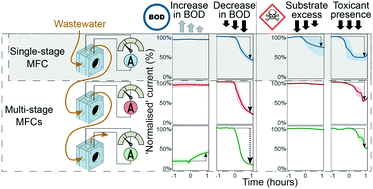A microbial fuel cell sensor for unambiguous measurement of organic loading and definitive identification of toxic influents†
Abstract
Microbial fuel cells can be used as sensors to measure organic load (measured as biochemical oxygen demand; BOD) in aqueous waste streams, but electrical current output can also be affected by the presence of toxic compounds. Just as BOD is a non-specific measure of organic loading the toxic response is not differentiated for specific toxicants and thus enables a generalised toxicity level to be monitored. To date combined BOD and toxicity sensing with a MFC has not been possible without comparison with reference feeds of synthetic solutions, as a decrease in signal caused by a decrease in BOD could not be distinguished from those caused by the presence of a toxicant in the waste stream. In this work, an innovative solution using a three-stage MFC sensor configuration was developed to explicitly distinguish BOD-related and toxicity-related signal decrease. A decrease in BOD led to an initial responses in the third, followed by the second and first stage MFC. For a decrease from 360 to 60 mg L−1 O2 BOD5 the decrease in normalised current density was 59%, 82% and 94% in the first, second and third MFC respectively. In studies using 4-nitrophenol as a model toxic compound, increasing 4-nitrophenol concentrations resulted in an approximately equal decrease in current in all MFC in the MFC array (63%, 66% and 74% respectively when exposed to medium containing 150 mg L−1 4-nitrophenol). Thus the magnitude and ordering of the response allowed a decrease in signal from decreasing BOD to be distinguished from the presence of a toxic compound. Furthermore, the MFCs were capable of recovering to previous performance levels within hours of acute exposure to toxicity. The multi-stage MFC configuration therefore enabled truly combined BOD and toxicity sensing with enhanced detection capabilities without the need for a defined or synthetic reference feed.



 Please wait while we load your content...
Please wait while we load your content...